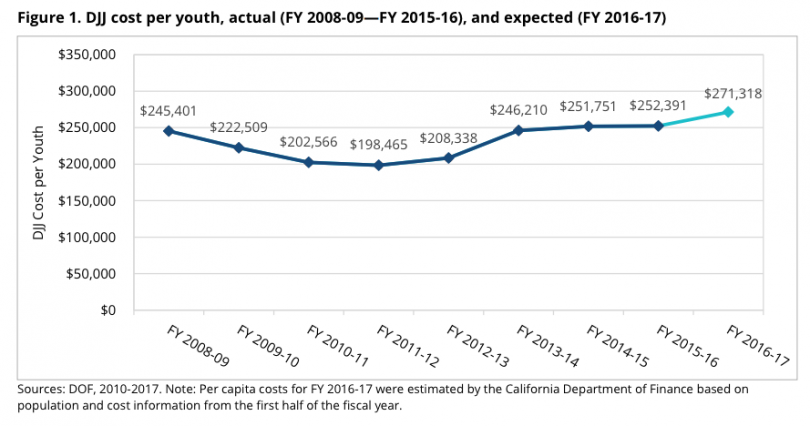As the number of kids locked in state correctional facilities in California has plunged, per capita juvenile incarceration costs have continued to rise, according to a fact sheet from the Center on Juvenile and Criminal Justice. Despite being one of the most expensive juvenile correctional systems in the nation, California’s Division of Juvenile Justice (DJJ) suffers from an alarmingly high recidivism rate among youth.
The DJJ is responsible for providing “education and treatment to California’s youthful offenders up to the age of 25 who have the most serious criminal backgrounds and most intense treatment needs,” according to the California Department of Corrections and Rehabilitation website.
The high rates of re-arrest, re-conviction, and return to state detention facilities, says CJCJ, is indicative of insufficient services and programs for locked-up youth and a failure on the part of the state’s juvenile justice system to “fulfill its rehabilitative mandate.”
The Cost Breakdown
During fiscal year 2016-2017, which ends in June, California is on track to spend an estimated $271,318 per youth—a record high.
Early budget estimates predicted that the state would spend $258,348 per locked-up kid during the current fiscal year. (According to CJCJ, the actual cost per youth was higher because there were fewer incarcerated kids than originally expected.) DJJ spending per youth has been on the rise since FY 2012-2013, when it jumped to $208,338 from the previous year’s $198,465. The next year was an even larger increase—to $246,210.
California’s 58 counties are only responsible for a small portion (approximately 9%) of DJJ’s costs. The other 91% comes from taxpayers. SB 1021 mandated that counties pay $24,000 each year for every youth sent to a DJJ facility from juvenile court. But when juveniles are charged as adults and sent to DJJ, the county does not have to pay the $24,000.
DJJ and Prop. 57
DJJ information on the outcomes of youth released from its facilities is full of holes, which limit’s the state’s ability to determine what impact DJJ, as it is currently run, has on public safety.
Earlier this year, a DJJ report revealed that 74.2% of youth released from a DJJ facility were re-arrested, 53.8% were re-convicted of new offenses, and 37.3% had been locked back up in a state facility within three years of release.
Thanks to the passage of SB 81, which narrowed the list of offenses that could land youth in DJJ facilities, the state’s DJJ population dropped by 35% between 2012 and 2017. While the DJJ population is currently less than 1% of the more than 200,000 young people arrested every year in California, the number of kids committed to DJJ may increase as voter-approved Proposition 57 is rolled out.
(Prop. 57 reversed a 2000 voter-approved law, Prop. 21, which gave prosecutors far more power to charge juveniles as adults, allowing prosecutors to bypass judges’ transfer hearings.)
Erica Webster, a CJCJ communications and policy analyst, told Oakland North that some believe more juvenile court cases may mean that more young people will be sent to DJJ facilities.
Prop. 57 offers “an opportunity for the state to reevaluate its reliance on DJJ and critically examine just how rehabilitative our juvenile justice system is,” said Maureen Washburn, a CJCJ policy analyst.
Juvenile court judges have other sentencing options that would likely prove more rehabilitative for youth than a DJJ facility, added Webster. Smaller county probation camps “that actually address issues that youth deal with that keep them local, keep them near their family, and their support network,” better serve those young people, many of whom are in need of specialized mental health services and substance abuse treatment.

